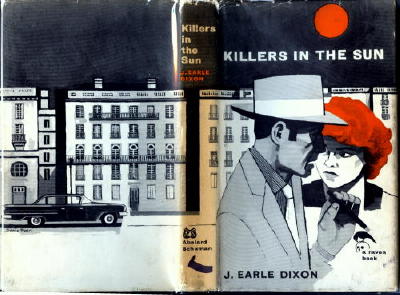Sun 9 Sep 2007
Mr. Dixon has but one title to his credit in Crime Fiction IV, by Allen J. Hubin. His entry, as it presently stands, is as follows:
DIXON, J. EARLE
Killers in the Sun (London: Abelard-Schuman, 1960, hc) [Spain] Abelard-Schuman (New York), 1961.
The book was published as part of Abelard-Schuman’s largely unknown and vastly under-rated “Raven Book” line of mysteries. You should be able to pick out the logo on the lower right portion of the front cover — that of a raven standing (and pecking) on a human skull.

Story synopsis, from inside the front cover:
“But then I was only in their midst a little while.
“This Larrabee case which brought me to Spain kept me there a matter of thirty days. That isn’t much time in which to study a nation. But I didn’t go there as a student; my job was to save First National (Australia) being gypped for three hundred thousand pounds. Which in my currency, is twenty-five per cent over sterling and is more than I earn in a month …”
But thirty days were long enough for insurance man Dixon to involve himself in the world of the bull ring, of the glamour of the peerless bull-fighter Senorita Rosita Romero, of failed matador Martelli and the more deadly world of the luscious Faith Larrabee, of the mysterious painter Ramsey, worlds which overlapped and which provided the answer to the riddle of Clive Larrabee’s suicide in this tough, fast-moving story.
If you couldn’t quite tell, or if you really weren’t sure, telling the story is Earle Dixon himself, a brash young insurance investigator from Sydney, which in essence qualifies him as a Private Eye in almost anyone’s book. That the author and the main character are one and the same makes one wonder about the author — a pen name?
Author information, from inside the back cover:
J. Earle Dixon writes of insurance because he knows it; he began his working career with a South African insurance concern in his youth. He has been married three times but isn’t working at it now; he claims women are unpredictable and unreliable.
He has two paramount desires — to direct films and write for the Saturday Evening Post.
Unfortunately, so far as I’ve been able to discover, he hasn’t, neither one, or at least not under that name. As usual, more information, if you have it, would be welcome.
May 7th, 2013 at 11:33 am
From John Herrington:
I recently sent [your inquiry re J. Earle Dixon] to Allen and the others, as well as a contact at the Australian literary database Austlit
“From blurb in the book the author was Australian born, travelled the world, has worked in insurance, and was then living in the Katoomba area of NSW. Trouble is, cannot find any such person in Australian BMD or on electoral rolls.
But I have just found this extract from ‘Southwords: essays on South Australian writing’:
‘Robertson Hobart, a pseudonym of Norman Lee (1905-1962), sets ‘Blood on the lake’ (Hale 1961) in northern South Australia, including the opal fields; it features the efforts of J. Earle Dixon, Adelaide insurance investigator. To locate a missing geologist’.
Have not seen the book to confirm this.
IN ‘Killers in the sun’ J Earle Dixon is not only the byline but also the first person main character who works in insurance.
A coincidence? Or something more. Especially as J. Earle Dixon does not appear to existâ€
The general consensus is that Dixon is Norman Lee, based primarily on the name J. Earle Dixon being unique and appearing in two books in the same year.
[Me again. This suggestion makes a lot of sense to me. Any reaction from anyone else?]